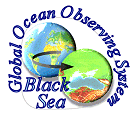Turkey
Turkey has funded activities on the following items in the Black Sea.
- general and process oriented surveys,
- time series studies and
- modeling activities for near time and/or real forecasting.
The changes in the quality and quantity of nutrients, phytoplankton and zooplankton are being monitored at two stations (one inshore station and one offshore station) at two-week intervals
for one year. The time-series data is used to study the biogeochemical processes of the Black Sea. At the end of this study some important biological characteristics (e.g. rates and period of growth, death and reproduction) of a few key species (the copepod Calanus euxinus, the ctenophore Mnemiopsis etc.) are also expected to be disclosed.
This study is an extension of the same project started last year. However, a few changes have been made to the sampling program based on the results obtained so far. Previously (during 1998) 4 stations off Sinop in the central southern Black Sea were being monitored for a few oceanographic parameters over monthly intervals. Since January 1999, two stations (one shallow ~75m and one deep ~400m) are being sampled for their basic pelagic biological (chlorophyll, phytoplankton and zooplankton) and physical-chemical characteristics (temperature, salinity, nitrate, phosphate, silicate, Secchi disk depth etc.)
at biweekly intervals.
At these two stations, chlorophyll, phytoplankton and nutrients (nitrate, phosphate and silicate) are being sampled from 7 different water depths (surface, 10m, 20m, 30m, 40m, 50m and 60 m). Phytoplankton and nutrient samples will be analyzed at the METU-Institute of Marine Sciences. For the measurement of basic oceanographic parameters (i.e. temperature and salinity), METU-IMS loaned an Acoustic Doppler Current Profiler to the Sinop Institute.
Zooplankton samples are being obtained by one vertical tow from the bottom to
the surface at the shallow station and from the lower border of the oxic zone (approx. 150 m) to the surface at the deep station. Following net towing, gelatinous organisms
(which are retained on a sieve) are counted and weighed individually for determination of their biomass. This is necessary for understanding the population dynamics of gelatinous organisms (mainly Aurelia aurita, Mnemiopsis leidyi, Pleurobrachia pileus and the new alien ctenophore Beroe sp),
this information is not known yet but is very important for the understanding and modeling of the pelagic ecosystem of the Black Sea.
The proposed project is expected to result in the creation of a time-series data of basic oceanographic parameters. Due to practical difficulties, unfortunately such a time-series
has not been available until now. Therefore, from the sporadic studies performed up to now, we have only a limited and very general understanding of the Black Sea ecosystem. By combining the data
obtained from short-term sampling studies, the knowledge of the Black Sea ecosystem could be utilized to explain spatial and temporal characteristics as well as for better modeling of
the ecosystem.
This project will also help, through transfer of technology and experience, from the METU-IMS, to the development of a new Institute
(Sinop Fishery Faculty of Ondokuz Mayis University, Samsun).
The location of the time series stations are given in figures.
Modeling the response of top-down control exerted by gelatinous carnivores
Recent changes in the structure and functioning of the interior Black Sea ecosystem are studied by a series of simulations using a one dimensional, vertically resolved, coupled physical-biochemical model. These simulations are intended to provide a
better understanding for how the pelagic food web structure has responded to increasing grazing pressure by gelatinous carnivores (medusae Aurelia aurita, and ctenophore Mnemiopsis leidyi) during its last two decades of evolution. The pelagic food web is represented by two groups of phytoplankton (diatoms and dinoflagellates), bacterioplankton, microzooplankton, omnivorous mesozooplankton, Aurelia, Mnemiopsis and the giant omnivorous dinoflagellate Noctiluca scintillans. Dissolved and particulate organic nitrogen as well as nitrate, nitrite and ammonium constitute its other components.
Modelling the summer mesoscale variability of the Black Sea
The Black Sea temperature, salinity and circulation from large to mesoscale are studied using a basin wide hydrographic data, ADCP data obtained in the multi-national CoMSBlack'92 experiment; wind stress derived from analyses of the Sevastopol Hydrometeorological Office; and climatological heat and water fluxes. Hydrographic data gridded through objective analysis and adjusted dynamically with a primitive equation model provides a snapshot of the circulation at mesoscale resolution for mid July 1992. A 50-day primitive equation model data driven simulation, taking into account atmospheric and riverine fluxes, is used to examine the evolution and dominant
variabilities and its dependencies during this summer period. The large-scale upper layer is characterised by, a generally cyclonic circulation over the deep portion of the basin with a system of anticyclonic eddies in its periphery. The largest anticyclonic gyre lies east of 38E. An inertial jet dominates the edge of the cyclonic circulation: the Rim current. As the Rim current transverses the edge of the deep basin, the meandering and secondary circulation of the jet varies according to its interaction with the topography and shelf waters. The north-western shelf circulation is populated with (anticylonic) eddies and a near coastal buoyancy flow of riverine origin. The seasonal thermocline is strengthened during this period and a zonal large-scale temperature gradient is supported by the observed relatively weak/strong winds/net heat fluxes in the east with respect to west. The layers with
a potential density, sg > 14.1kg/m3 are partially in contact with the atmosphere. The deep basin main pycnocline sg[14.2 - 16.2] intersects the bottom in the range of 35 - 120m. Temperature and salinity on isopycnals surfaces with sg > 14.3 are essentially homogenised. The data driven simulation predicts an active circulation below 500m. The major circulation elements described above are partially verified using qualitative comparisons with
the data obtained in the summer of 1992 and the data obtained previously; both in situ and
with infrared and colour remotely sensed data. The Rim current meander shape and propagation parameters, eddy size and distribution and the generation of rapid surface bound jets,
and squirts are found to be in good agreement with the observations.
|

